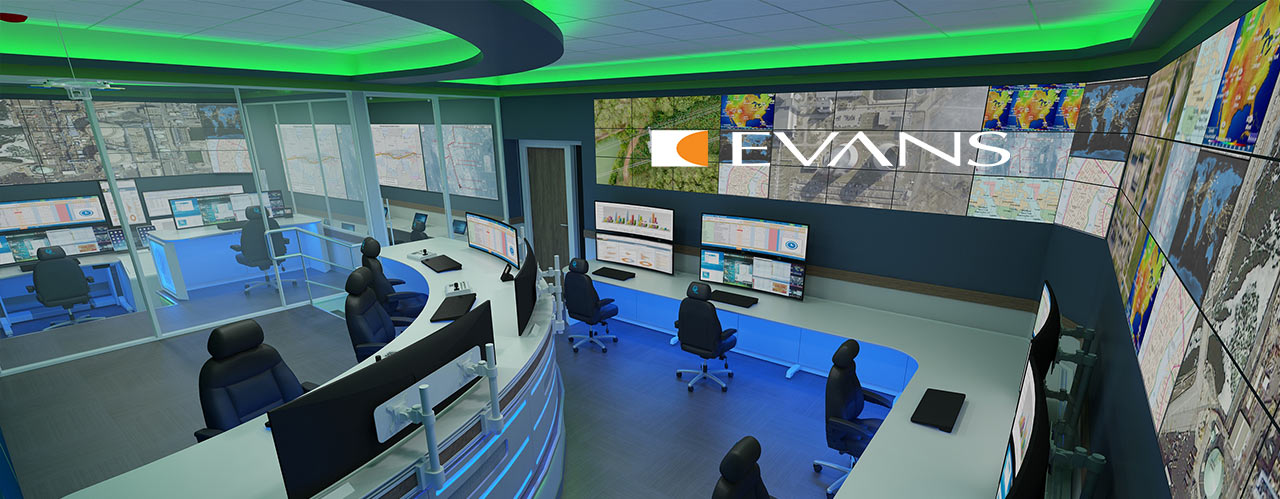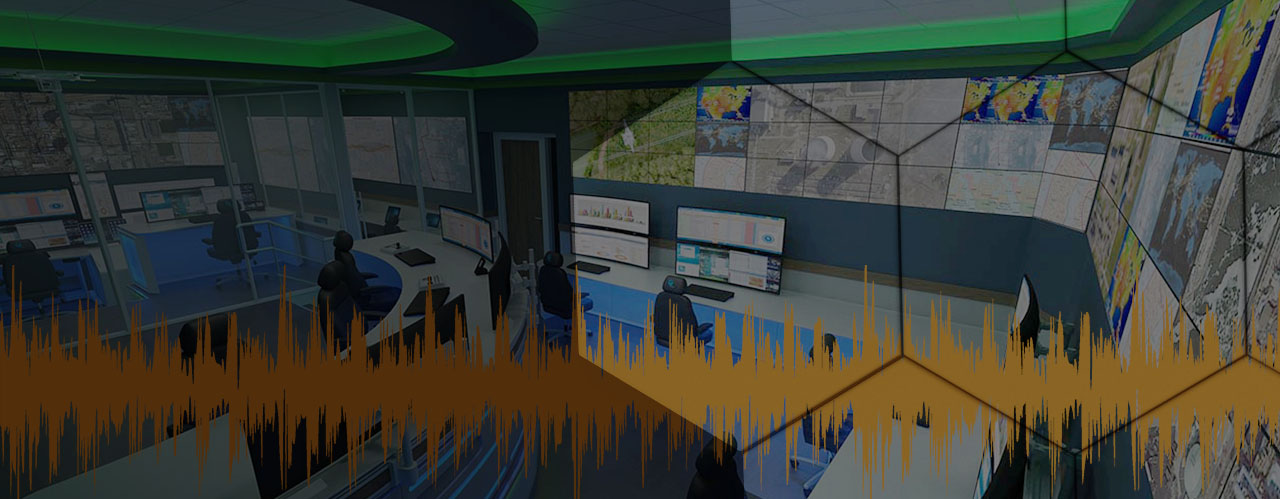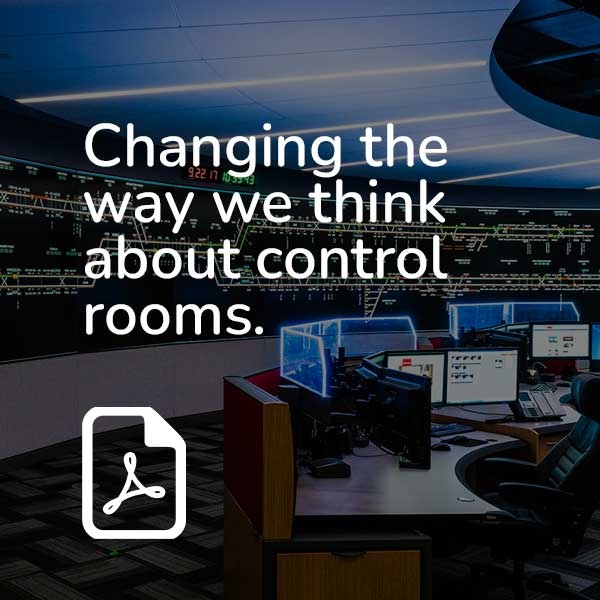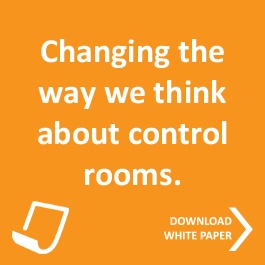- Blog
- Control Rooms (26)
- Events (21)
- Public Safety (21)
- Team (19)
- Ergonomics (9)
- Product (8)
- Mission-Critical (7)
- Console Cleaning (5)
- Air Traffic Control Towers (4)
- Acoustics (3)
- Denise Amber Lee Foundation (2)
- Government (2)
- NASA (2)
- GSOC (1)
- Oil & Gas Control Rooms (1)
- Project of the Month (1)
- Virtual Reality (1)
- Warranty (1)
The control center is the hub of any mission-critical operation whether in industrial plants, utility rooms, or dispatch and communication centers. The control center operator is responsible for critical communication and monitoring complex systems and environments, regardless of the application. Situational awareness and reduction of distractions are paramount in the planning and implementation of innovative control room solutions.
How Can Evans Help You Create Effective Control Room Acoustics & Keep Control Room Operators Healthy?
Due to varying operator conditions, equipment adjacency, audible alarm requirements, and individual operator personalities, there is no "one size fits all” solution when it comes to noise ergonomics. Instead, Evans recommends a layered approach to control room acoustics.
In monitoring and control applications, concentration is critical. Ambient noise in these environments can inhibit communication and workflow efforts. Operator ergonomics in the form of physical, organizational, and cognitive need to be applied to support the facility's required functions and reduce operator distraction. Workplace noise is noted to be one of the most significant distractions that impede operator productivity. How sound behaves in the control room environment can negatively affect the communication, productivity, and situational awareness of operators.
When dealing with control room acoustics, there is a multitude of factors that come into play. A common complaint from operators is noise level. Working in a noisy environment contributes to reduced productivity and overall well-being. It is important to use noise control methods and recognize each factor to determine which control room acoustic design options best suit the space.

What Types of Noise Do We See in the Control Room Environment?
It is important to study what types of noises are currently present in the control room early in the design process. Equipment hum, audio components, and other technology-reliant communications are all factors of noise ergonomics. This also includes vibration from adjacent equipment and verbal communication within the control room. Here are 2 types of noise that impact operator workflows and control room acoustics:
Airborne Noise in Control Room Acoustics
Airborne noise is most of the noise recognized by the human ear. It is noise relayed and bounced through the room. Airborne sound comes from everyday noise such as operator voices, radios, computers, situational alarms, and audible plant alarms (console level and room level). Airborne noise easily travels from space to space, affecting not only those in the control room but other operators in separate rooms. Have you ever wondered if airborne noise negatively affects productivity in your control center?
Impact Noise Can Adversely Affect Operators
Impact noises are sounds that pass through structures. When an object contacts another object, not only does the impact create noise, but it can also be a direct line for sound travel. Types of impact noise include equipment hum, or an operator walking across the floor. The floor bears the brunt of impact sounds, and all impact sound together can generate a lot of noise. This noise directly impacts operators in the room and on floors below. Noise reduction design creates a more ideal work environment for the entire operation. Which noise control methods have your management team taken to reduce distraction?
Ambient Noise Recommendations for Control Room Acoustic Design
Other typical control room noise includes HVAC systems, vibrating plant equipment, turbines, nearby rail lines, or traffic noises. Outdoor environmental conditions also factor in things such as wind or hail. The maximum recommended ambient noise level is 45 dB. In general, background noise levels should be between 30 - 35 dB. More importantly, the noise level for alarms needs to be louder than the ambient noise so that operators can hear them. Alarms should be 10 dB above the ambient noise level to a maximum of 15 dB above ambient noise. This is important because audible alarms should be easily detected by operators.
There are different noise control methods you can implement according to ISO 11064. Noise reduction designs must focus on:
- Reducing reverberation,
- Reducing sound levels and,
- Reducing environmental noise.
Evans will help you consider control room acoustics from all 3 of these categories when designing and installing your control room. Contact us today with any questions you may have.

What Sound Ratings Are Most Commonly Used in Control Center Acoustics?
To suppress and mitigate sound, multiple types of materials and products can be used. Evans recommends the layered approach of using multiple materials to create the best working environment for operators with minimal distractions.
There are two types of sound rating systems for noise reduction design. Consider them when building a control center with better control room acoustics.
Sound Transmission Class Rates Sound Blocking in Control Room Acoustics
Sound Transmission Class (or STC) is a rating of a product's ability to block sound from traveling through ceilings, walls, or other solid building materials. It is a measurement of how well that material transfers airborne sound. It is widely used to rate interior partitions, ceilings, floors, doors, windows, and exterior walls. It is a standardized measurement to compare materials and products. A higher STC rating means the materials are better at blocking sound effectively.
STC, however, only measures between 125Hz to 4000Hz. This means that low-frequency sounds are not accurately captured in an STC rating. Low-frequency sounds include heavy equipment and engines. Do you know the STC rating of your Control Room products? Here at Evans, we can calculate the amount of acoustic material you need based on the STC rating of building components. This will help achieve the desired reverberation time thus reducing overall noise.
The Noise Reduction Coefficient Provides a Rating for Sound Absorption
A Noise Reduction Coefficient (or NRC) is a rating of how much sound an acoustic product can absorb and mitigate when sound hits its surface. The rating scale is from 0 to 1.00, with 0 meaning no sound absorption, and 1.00 being 100% of the sound is being absorbed. Calculating NRC takes specific equipment in specialized labs to properly measure a product or materials rating that includes measuring at four different frequencies for an accurate measurement.
A quick recap on Sound Transmission Class (STC) and Noise Reduction Coefficient (NRC). Remember that STC prevents sound from entering or leaving a room whereas NRC reduces sound and reverberation in the room itself. If you have any questions about these terms, please do not hesitate to reach out to us.
Acoustic Partner Highlight: Holosonics Audio Spotlight
There are other ways to reduce your Noise Reduction Coefficient. One of the most effective noise control methods is the use of directional sound. If your control room uses speakers for audible alarms or any other purpose this technology can be a game-changer. One of our partners is Holosonics and their technology is amazing. Speaker sound can be directed only to those who need to hear it, thus reducing noise for all other operators. This quote directly from the Holosonics website explains it very well:
“Audio Spotlight directional sound technology creates a tight, narrow beam of audio that can be controlled with the same precision as light. By aiming an Audio Spotlight speaker at the desired listening area, the sound is focused specifically on one listener while silence is maintained in the immediate area that surrounds the beam of sound.”
Learn more about the applications of directional sound in the command center and control rooms from Holosonics.
How Can Evans Help You Achieve Effective Control Room Acoustics?
Effective control room acoustic design is a critical aspect of supporting operator situational awareness. Understanding the basics of control room acoustics will help operators and facility management professionals understand the importance of material choice and room design. This post is not primarily about room design, but you will want to consider the following questions when thinking about acoustics and room design:
- Does your layout plan consider noise locations and noise sources?
- Are you considering the overall building design, the individual control room(s), and console equipment type/positioning?
- Does your control room construction design consider speaker locations, acoustic paneling, and materials?
Choosing an effective noise reduction design helps to create the ideal control room environment. Using different sound-rated materials to mitigate and absorb airborne and impact sound will influence an operator’s productivity and concentration. Here at Evans, we are experienced in creating optimal control room acoustics, so please reach out to us with any questions you may have.
This was the first part of a two-part series on Acoustics. In part 2, we will outline different areas of the control room and what can be done to best mitigate and optimize sound. Hint: it will get you looking both up and down to see how your acoustics can be improved.
The second part will be posted within the next 2 weeks so stay tuned. In the meantime, read more on our blog or learn more about our innovative control room solutions here.
As always you can reach out to us through our contact form to discuss specific details about your project. To learn more about how technology can impact the design and function of modern control room environments then download the insightful white paper: “Changing the Way We Think About Control Rooms”.
Topics: Ergonomics, Acoustics, Control Rooms

